2/1/2021
Best Practices for Biocontrols, Part 1
John Sanderson, Suzanne Wainwright-Evans & Ronald Valentin
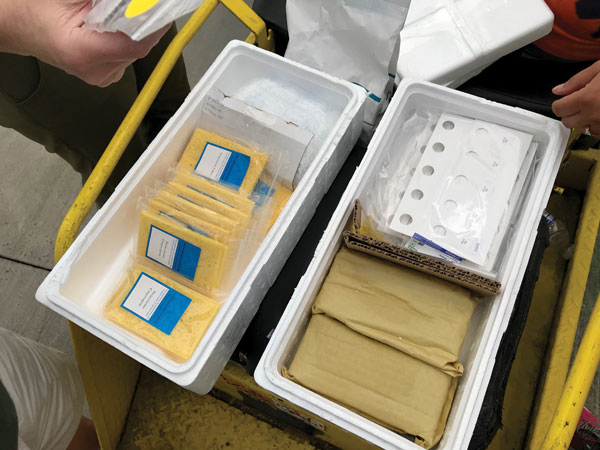
Let’s say you’ve figured out which biocontrol agents (BCAs) to use for the various insect and mite pests on your greenhouse crops, found a reputable supplier, ordered the correct quantity of the BCAs, and they’ve been shipped and should be arriving at your green-house at the perfect time. These are all critical steps toward successful biocontrol.
Figure 1. Inside a new shipment of biocontrol agents.
But, actually, you might have missed a crucial step. Even before you place your order for your BCAs, you need to be ready for their arrival. To get ready, there’s more you should know about the preparations that need to be made.
Conditions vary for different BCAs, so without proper care and attention, your BCAs could be weakened or killed, wasting your money and having no effect on your pests. This article will provide some advice for checking a BCA shipment and guidelines for proper storage of many BCAs. (Note: This article also only pertains to living BCAs such as predators and parasitoids [including insect-killing nematodes], not biopesticides.)
Your BCAs are here—now what?
BCAs are living organisms that require proper environmental conditions to survive during shipping and storage, so it’s important for you to be able to check if your BCAs have arrived in good shape (Figure 1). And if you cannot release them immediately into your crop (which is always preferable), then how should they be properly temporarily stored and for how long?
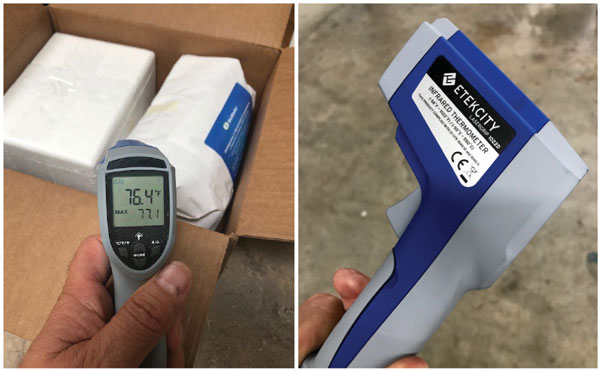 The reputable companies that produce and distribute BCAs go to great lengths to ensure the quality of their BCA products, regularly doing quality-control checks to make sure that their products meet certain standards before they’re shipped. They also evaluate their product packaging and shipping practices to be sure that the BCAs are in good condition and are packaged carefully, with enough ice packs and insulation to keep them sufficiently cool during shipping, taking into account the weather conditions during the course of the entire trip from their facility to yours.
The reputable companies that produce and distribute BCAs go to great lengths to ensure the quality of their BCA products, regularly doing quality-control checks to make sure that their products meet certain standards before they’re shipped. They also evaluate their product packaging and shipping practices to be sure that the BCAs are in good condition and are packaged carefully, with enough ice packs and insulation to keep them sufficiently cool during shipping, taking into account the weather conditions during the course of the entire trip from their facility to yours.
Figure 2. Measuring the internal temperature of a new shipment of BCAs. An inexpensive IR thermometer can be used to measure the internal temperature of a new box of BCAs to check whether they’ve been exposed to temperature extremes.
Still, for many unexpected reasons, things can go wrong during transit. Releasing dead or weakened BCAs onto your crops won’t result in adequate pest management. Growers need to check that the BCAs in a new shipment are in good shape.
Here are some things to do with a new shipment and what to look for to check for problems:
When your box(es) arrives, keep it/them shaded and sheltered upon arrival, even if the box is unopened. Do not allow boxes to sit in hot sunlight. Use package tracking information to anticipate when a shipment should arrive so that it won’t be left outdoors in the hot sun or cold snow. Have the storage areas ready for them before they arrive and know how each needs to be stored. Large greenhouse operations that have a shipping/logistics department must coordinate with the pest management department to alert as soon as a shipment arrives so there’s no delay.
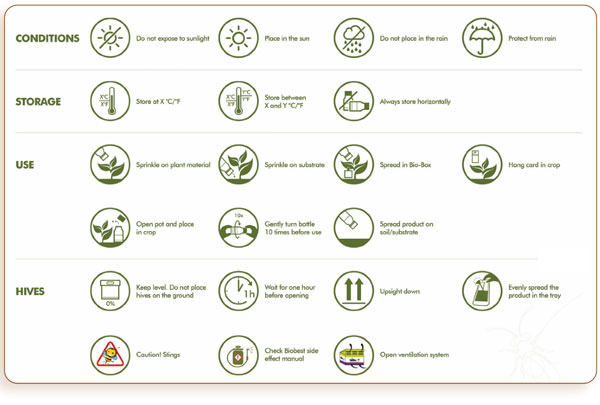 Check the internal temperature within the box as soon as it’s opened. Consider using an inexpensive infrared thermometer to check the temperature (Figure 2). Are the ice packs still frozen or at least cool, or are they at room temperature? Is there a lot of wetness or condensation in the box contents? Is there a moldy, rancid or “off” odor? These are all signs that things might have thawed at some point and that there might be a problem. Checking the viability of the BCAs will be especially important.
Check the internal temperature within the box as soon as it’s opened. Consider using an inexpensive infrared thermometer to check the temperature (Figure 2). Are the ice packs still frozen or at least cool, or are they at room temperature? Is there a lot of wetness or condensation in the box contents? Is there a moldy, rancid or “off” odor? These are all signs that things might have thawed at some point and that there might be a problem. Checking the viability of the BCAs will be especially important.
Figure 3. Icons on the label of a bottle of aphid parasitoids. Icons can often provide information on proper storage conditions.
You may also find sometimes that some of the beneficials have escaped into the shipping box. Rove beetles (Dalotia coriaria) are pretty good at this. If it’s just a few, you don’t need to worry, but if there are many loose in the shipping box, a container has come open, so contact your supplier immediately.
Here are two helpful guides that detail how to check that your recently shipped BCAs are in good shape and in the appropriate numbers. The second guide contains more extensive and detailed information than the first, but some growers say that the first is more “grower-friendly.” Both are very useful:
• Brian Spencer, Applied Bio-nomics Ltd.: “How to Check the Quality of Biological Control Agents” (appliedbio-nomics.com/wp-content/
uploads/170-quality.pdf)
• Rose Buitenhuis, Ph.D., Vineland Research and Innovation Ctr.: “Grower Guide: Quality Assurance of Biocontrol Products” (vinelandresearch.com/wp-content/uploads/2020/02/Grower-Guide.pdf)
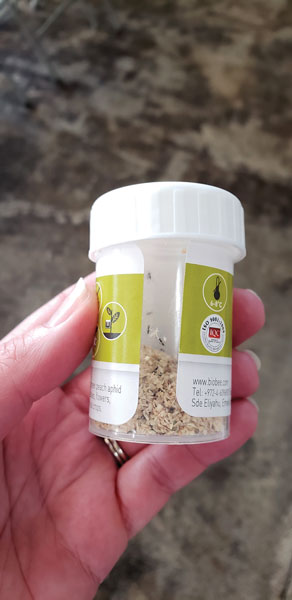 If there seems to be a problem with the shipment, contact your supplier immediately. Be sure to understand what their policy is on filing for a damaged shipment before you order. Do not wait several days before checking the quality of a new shipment or it will be difficult to determine whether the problem occurred before or during shipping, or while it was under your care. The supplier will also want to know if there’s a problem and the conditions that might have caused it in order to improve their products or practices.
If there seems to be a problem with the shipment, contact your supplier immediately. Be sure to understand what their policy is on filing for a damaged shipment before you order. Do not wait several days before checking the quality of a new shipment or it will be difficult to determine whether the problem occurred before or during shipping, or while it was under your care. The supplier will also want to know if there’s a problem and the conditions that might have caused it in order to improve their products or practices.
It’s always best to release the BCAs as soon as they arrive and avoid possible problems with storing them. But immediate releases may not always be possible during exceptionally busy times. If you must store the BCAs, then when you’re finally ready to release them, it’s advisable to do viability checks prior to releasing them to be sure that they’re in good shape.
Figure 4. Some companies provide a guide for all the icons they use on their product labels.
BCAs that haven’t emerged as adults yet from their pupal stage, or those that have a source of food mixed into their container, may endure storage better than those without a source of food, such as the spider mite predator Phytoseiulus persimilis, which should be released as soon as possible.
Before describing a few specific guidelines about BCA storage, you should be aware that some companies print icons on their containers or packaging that indicate important points about how to use the product (Figures 3 and 4). Often these include proper conditions for storage (e.g., temperature, humidity, container orientation), as well as instructions for how to release the BCAs. Some companies provide a guide for all the icons they use (Figure 4). Some companies also provide guidelines for storage of their products on container labels or on an information sheet for all their products.
Also, be sure to check the dates on the products and know what the dates mean. Some will have dates for when the BCAs were produced and others will have “use-by” dates. Some dates are done by week number and others can be in European dating format. Ask your supplier to explain their system to you. Keep in mind these dates are put on by the BCA producer and if you’re using a distributor that has the product shipped to them first, this reduces the time you have to get them released.
Products containing predatory mites, such as Neoseiulus cucumeris and Amblyseius swirskii, are sensitive to low humidity (<60% RH). Sachets for these mites include a “food mite” for the predators and these food mites feed on fungi and yeasts that grow on the bran in the mixture. The low humidity kills these microorganisms, thus starving the food mites and eventually the predators. Even though an air-conditioned office or breakroom may provide cool temperatures, often the air is so dry that the mites are ultimately harmed. Refrigerators and coolers can also have low humidity and be harmful, plus they may be set below the correct storage temperatures (60F/15C for A. swirskii and 50F/10C for N. cucumeris). It may actually be better to store these mites in the coolest shade of a headhouse or greenhouse where the humidity is higher (Figure 5). It’s also best to open the shipping box(es) of sachets or bulk products upon arrival to provide fresh air for the mites.
It’s also important to always keep the bottles of various BCAs, especially the predatory mites, horizontally on their sides, not vertically standing up. You may note that these bottles are always arranged in this fashion in the shipment box. It can’t hurt to keep all containers of BCAs on their sides. Some producers have changed the orientation of their labels to be read horizontally.
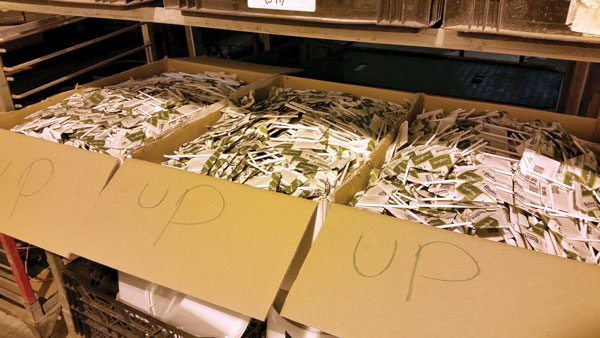 Figure 5. Boxes of sachets of Neoseiulus cucumeris stored in shade in a cool place in a greenhouse where relative humidity will be higher than in an air-conditioned office, refrigerator or cooler. The mites in the sachets can be harmed by low relative humidity.
Figure 5. Boxes of sachets of Neoseiulus cucumeris stored in shade in a cool place in a greenhouse where relative humidity will be higher than in an air-conditioned office, refrigerator or cooler. The mites in the sachets can be harmed by low relative humidity.
Here are some suggestions for storing some common BCAs, gleaned from information provided by various suppliers. (Contact your supplier for more detailed information; these are baseline guidelines.):
• Aphidius aphid parasitoids (A. colemani, A. ervi, A. matricariae): Shipped as parasitized aphids (mummies) in bottles or blister packs, and mixed into buckwheat hulls, sawdust or no carrier. Some suppliers add a sugar source in their packaging to sustain any emerged wasps. Store bottles on side horizontally for one to two days at 42 to 50F (5 to 10C).
• Aphidoletes aphidimyza midges for aphids: Shipped as pupae mixed into sawdust or vermiculite. They may be packaged in trays, bottles or blister packs. Store bottles horizontally. Store for one to two days at 50 to 59F (10 to 15C).
• Encarsia/Eretmocerus whitefly parasitoids: Shipped as parasitized whitefly pupae glued to cards or as loose pupae in sawdust carriers in bottles or blister packs. Wasps emerge from the pupae on these cards or from the loose pupae in the carrier. If no wasps have emerged upon arrival, then no need to refrigerate unless releases must be delayed for more than a couple days. If using bottles, store horizontally, not vertically. Best to use immediately, but should be stored no more than one to two days at 47 to 50F (8 to 10C).
• Phytoseiulus persimilis spider mite predators: Usually shipped as adults mixed into sawdust or vermiculite or with no carrier in bottles, tubes or vials. “Hot shot” bottles with nipple tops enable spot-releases of pure P. persimilis onto plants with no carrier. Do not store; release immediately. P. persimilis arrives very hungry and will begin to starve if they’re stored for longer than a day without food. However, a product is now available that includes a food source for these predators so that they’ll have food during travel and brief storage. Also, all life stages of the predator are in the container of this new product.
• Steinernema feltiae, S. carpocapsae insect-killing nematodes: Insect-killing nematodes are shipped in a carrier in sealed trays, bagged product or on sponges in sealed bags. These store well in a refrigerator as long as the package isn’t opened. The nematodes in sealed trays will retain good viability for about four weeks at optimum storage temperatures of 38 to 40F (3 to 4C), but check the expiration date on the package. Be sure there’s good air circulation around each tray. Do not freeze. Do not store in a refrigerator where there’s food or drink. The door will be opened and closed many times a day, causing temperature fluctuations that can impact the quality of your beneficials. Nematode products that use sponges as the carrier should be used immediately upon receipt, but if necessary can be stored unopened at 41F (5C) for no more than one to two weeks.
Remember these beneficials are working for you, so treat them kindly by being prepared and informed about your BCAs and you’ll get the most killing power out of them. GT
John Sanderson is an Associate Professor at Cornell University in Ithaca, New York, and has worked on research and extension for greenhouse pest management for over 30 years. Suzanne Wainwright-Evans is the owner of Buglady Consulting, now in business 20 years. She specializes in biological control agents and troubleshooting pest issues in ornamentals, cannabis and other specialty crops. Ronald Valentin is Technical Director BCA for BioWorks, Inc. and has been active in Biological Control for over 30 years in Europe, Canada and the U.S.
More information about greenhouse biocontrols and which BCAs to use for which pests:
• ipm.uconn.edu/pa_greenhouse (Basics on biological control)
• anbp.org (Association of Natural Biocontrol Producers)
• onfloriculture.com/category/biocontrol-agents (Blog on greenhouse pest management)
• Bugladyconsulting.com (Various articles on pest management and biological control)